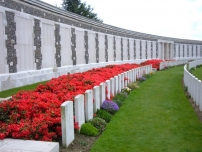| First Name: | Frederick | Last Name: | MYCROFT | |
|---|---|---|---|---|
| Date of Death: | 22/09/1917 | Lived/Born In: | Lee | |
| Rank: | Private | Unit: | Middlesex23 | |
| Memorial Site: | Tyne Cot Memorial, Belgium | |||
Current Information:Enlisted-Camberwell
Third Battle of Ypres This was a campaign fought between July and November 1917 and is often referred to as the Battle of Passchendaele, a village to the north-east of Ypres which was finally captured in November. It was an attempt by the British to break out of the Ypres salient and capture the higher ground to the south and the east from which the enemy had been able to dominate the salient. It began well but two important factors weighed against them. First was the weather. The summer of 1917 turned out to be one of the the wettest on record and soon the battlefield was reduced to a morass of mud which made progress very difficult, if not impossible in places. The second was the defensive arrangements of concrete blockhouses and machine gun posts providing inter-locking fire that the Germans had constructed and which were extremely difficult and costly to counter. For 4 months this epic struggle continued by the end of which the salient had been greatly expanded in size but the vital break out had not been achieved. The Battle of the Menin Road. 20th-25th September, 1917 After the disappointing opening battles of the last day of July and the middle of August, when very little had been gained but at great cost in casualties, a new approach was adopted for the next offensive against the Gheluvelt plateau which began on 20th September and became known as the Battle of the Menin Road. The task was handed over to General Plumer, commander of the Second Army, a more cautious leader who, rather than try to drive as deep as possible into the German line, was an advocate of 'bite and hold' tactics with limited advances of no more than 1,500 yards, based on overwhelming firepower and exhaustive preparation. These new tactics, which were significantly aided by a period of warm, dry weather, worked well and September and early October saw a decisive phase of Third Ypres in which the British gained the upper hand. At the same time that Plumer’s Second Army were hammering away at the German defences on the Gheluvelt plateau, Fifth Army also attacked in the northern part of the Ypres salient and they too made gains. At 5.40am on 20th September, 122 and 124 Brigades of 41st Division attacked from a position south of the Menin Road, through the northern part of Shrewsbury Forest with the Tower Hamlets Ridge as their objective. 123 Brigade were in reserve and when the attack was launched they moved forward to the now vacated old front line. In front of them the attack succeeded in gaining the first two objects but lacked the necessary clout to go further. At noon, the 23rd Middlesex battalion were ordered forward to lend their weight to the attack. They left Larch Wood at 1pm, arrived at Canada Tunnels an hour later and at 4.30pm began their advance on Java Trench. They were met by machine-gun and rifle fire from their front and their right flank and took shelter where they could find it. The slightest movement drew fire which did not auger well for the attack planned for 6.30pm. At that time there was a new artillery barrage behind which B and C Companies advanced in extended formation and short rushes. They reached the Blue Line to the west of the Bassevillebeek valley but here heavy fire prevented any further advance and they consolidated. Later that evening they dispersed enemy troops concentrating on the ridge in front of them. At 9.30am on the following morning a frontal attack was made by the 10th Royal West Kent and 20th Durham Light Infantry battalions during which 23rd Middlesex advanced in short rushes to the Bassevillebeek and the copse there and where the ground was a quagmire. At 7pm they were attacked by German troops advancing in five lines but the British artillery stopped them in their tracks., leaving nothing living left. 23rd Middlesex clung to these positions, under constant shell-fire until relieved during the night of 22nd/23rd September. One of those who did not survive this operation was Frederick Mycroft. |
||||
| « Back to Search Results | ||||
| If you think any of the information shown here is incorrect, Click Here to submit your amends and comments | ||||




